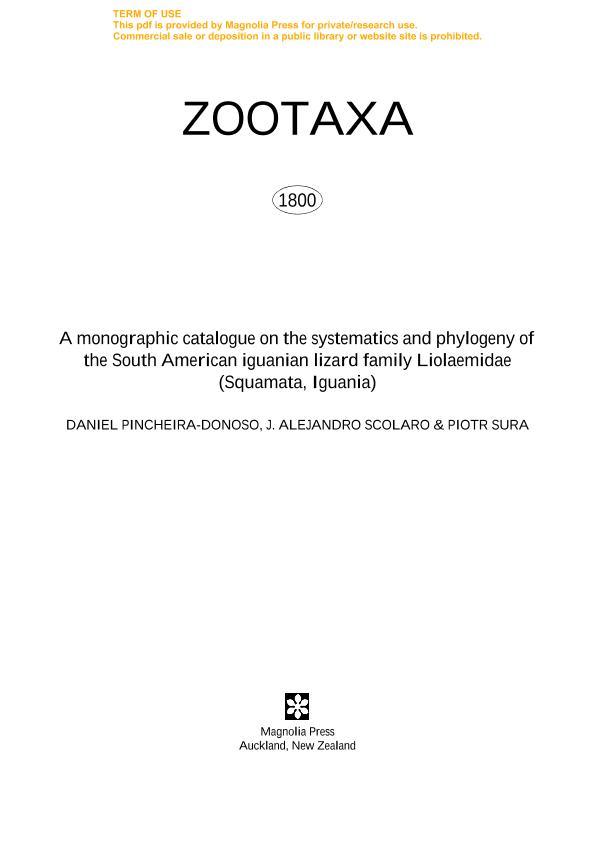Artículo
A monographic catalogue on the systematics and phylogeny of the South American iguanian lizard family Liolaemidae (Squamata, Iguania)
Fecha de publicación:
06/2008
Editorial:
Magnolia Press
Revista:
Zootaxa
ISSN:
1175-5326
e-ISSN:
1175-5334
ISBN:
978-1-86977-238-3
Idioma:
Inglés
Tipo de recurso:
Artículo publicado
Clasificación temática:
Resumen
Iguanian lizards concentrate two of the three most species-rich vertebrate genera on Earth. Therefore, the development of studies to understand their diversity and phylogenetic relationships may have a major significance for ecological and evolutionary research. Nevertheless, at the same time, many difficulties are often associated to these highly speciose groups. For example, the impact of adaptive radiations may promote the development of conspicuous patterns of intraspecific variation as response to local environmental conditions in asbence of real events of speciation, leading to the taxonomic recognition of new species with no clear biological boundaries. In addition, although rich groups are appropriate models to evaluate the effects of selection on ecological (e.g. morphological, behavioural) and life-history traits, it is often a major challenge to gather all the available information on the distribution of these characteristics across all the known species. It makes desirable the development of synthesis works. Here we present a monographic catalogue on the diversity and phylogenetic structure of the entire South American iguanian subfamily Liolaeminae, based on previously published studies. We also provide a complete table to summarize the distribution by country, elevational range, diet and reproductive mode of each species for which this information is available. The Liolaeminae subfamily consists of a total of 224 species and subspecies belonging to the genera Ctenoblepharys, Liolaemus and Phymaturus. Remarkably, however, only the genus Liolaemus concentrates 205 of these taxa, consisting of 195 species, six of them polytypic, and recognized on the basis of 16 subspecies. Liolaemus species occur in Argentina, Bolivia, Brazil, Chile, Paraguay, Peru and Uruguay, representing the widest range of environments occupied by any lizard lineage. In contrast, the genus Ctenoblepharys is monotypic (Ctenoblepharys adspersa) and endemic to Peru, while Phymaturus is known on 18 species distributed in Argentina and Chile. In these lizards, plant consumption and viviparity are strikingly common. Among Liolaemus, diet information was available for 150 taxa. We found that 74 are arthropofagous, 69 omnivorous and seven strictly herbivorous. Reproductive information was gathered for 133 species of this genus, being 72 viviparous (live bearing) and 61 oviparous (egg laying). In Phymaturus, dietary information for 17 species revealed that 16 are herbivorous and only one omnivorous. Concerning parity mode, all these species are viviparous. Ctenoblepharys adspersa is arthropofagous and oviparous. As previously supported theoretically and empirically, plant consumption and viviparity are directly associated to high latitudes and elevations. Finally, we suggest that the recently proposed species Phymaturus dorsimaculatus is conspecific to P. vociferator, from which the former taxon does not differ in morphology, coloration, patterns of sexual dimorphism or geographical distribution.
Palabras clave:
PATAGONIA
,
LIOLAEMIDAE
,
PHYLOGENY
,
TAXONOMY
Archivos asociados
Licencia
Identificadores
Colecciones
Articulos(CCT-CENPAT)
Articulos de CTRO.CIENTIFICO TECNOL.CONICET - CENPAT
Articulos de CTRO.CIENTIFICO TECNOL.CONICET - CENPAT
Citación
Pincheira Donoso, Daniel; Scolaro, Jose Alejandro; Sura, Piotr; A monographic catalogue on the systematics and phylogeny of the South American iguanian lizard family Liolaemidae (Squamata, Iguania); Magnolia Press; Zootaxa; 1800; 1; 6-2008; 1-85
Compartir
Altmétricas




